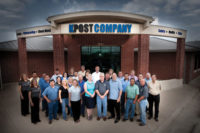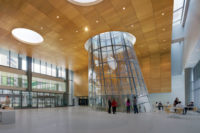
I have been in the contracting business all my life and have been doing EIFS work since the early 1970s. Among the many things I've learned over that time is a fact that seems to apply to a lot of things in life: People have difficulty handling change. In that regard, I am like most people. My personal philosophy is that if something isn't broken, it doesn't make a whole lot of sense to fix it.
However, my distributor recently told me that a new finish was coming out. I have been accustomed to using this manufacturer's products for the 20-plus years I have been putting EIFS on walls all over the state of Florida. I was asked to field test its new E Finish, manufactured by Dryvit, and this month's Bench Test describes the experience.
The subject
I decided to test the E Finish on a medical/educational building project we were working on in Jacksonville about seven months ago. The project involved about 4,000 square feet of finish on a metal-studded building with Dens Glass Gold as the substrate and the Dryvit Outsulation MD system on the wall.The manufacturer claimed that the E Finish was 40 percent lighter in the pail but retained the same characteristics as the company's traditional finishes. The lightness was supposed to make it easier to handle on the job site and reduce potential for job-related injuries. The pails are indeed lighter. As the journeymen unloaded the truck, the foreman came over to complain we had been shorted at the factory! But once open, we discovered the buckets were indeed full. Compared to the traditional buckets, these were much lighter and easier to carry.
As an owner, worrying about workers compensation claims is a very big deal and I believe this product can reduce that potential due to its light weight. Satisfied that the company was truthful about its ergonomic benefits, I still wanted to see how it performed on the wall. Would it be as easy to work with as traditional finish? Would it have the same performance characteristics? How would it hold up on the wall over time? Would my customers be pleased with the work?
Easy on the walls
Once the crew began to spread it on the wall, they confirmed that it was easier to work with. I tried it myself and they were right. The lightness made it easier to handle on the hawk and apply with the trowel. Anyone familiar with this work knows that working a wall over a full day is a workout for the arms, shoulders and back. The lightness made the entire crew more productive. Since it spreads easier there was also less waste than usual. Less of the product ended up on the ground and that means more went on the wall. Better coverage area out of the bucket.The best performance feature, at least from my perspective, is the way it floated. If you let it set up just a little bit for a short period of time, it honestly floated like butter. It is that smooth with a creamy consistency.
Resulting numbers were also positive. After the job was finished, we tracked project costs as we always do and found we saw just under 10-percent savings on our labor costs. That figure was a little bit lower than the manufacturer predicted but it was close and it was our first job with the product. The numbers could improve as we get more familiar with it.



Report Abusive Comment